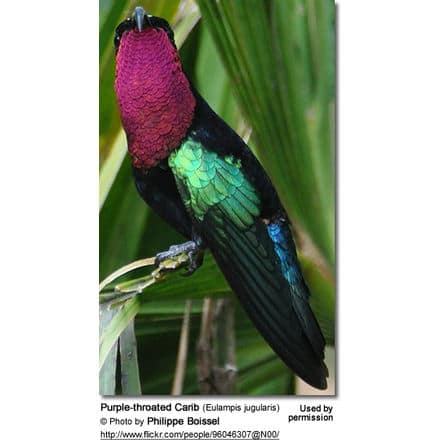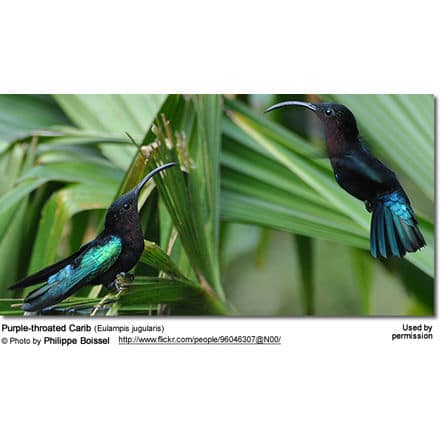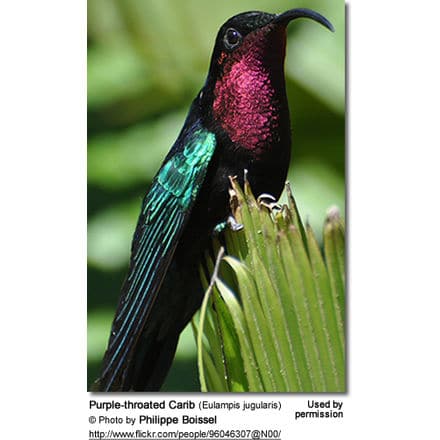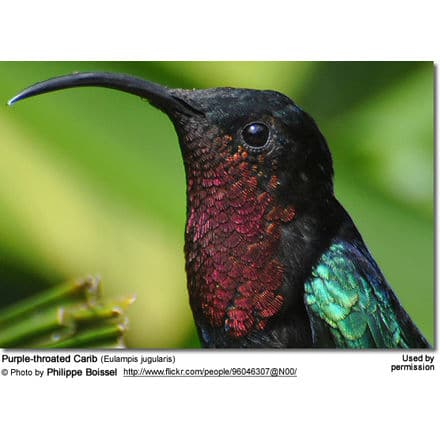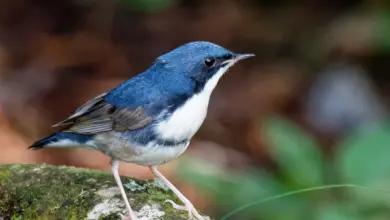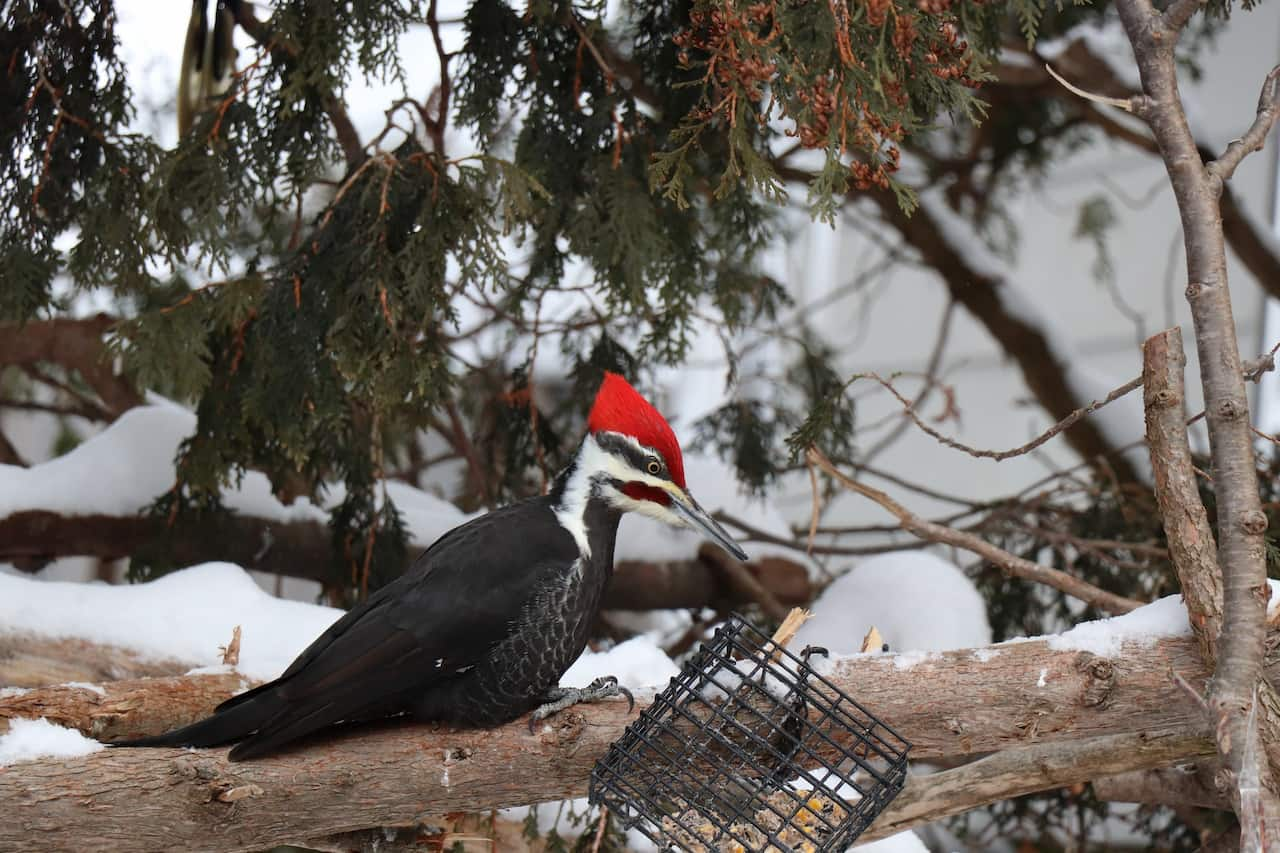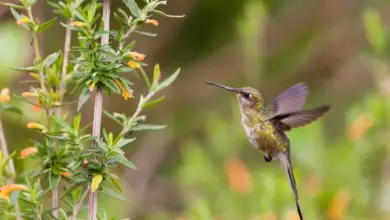Purple-throated Caribs – Hummingbirds
Hummingbird Information
The Purple-throated Caribs (Eulampis jugularis) – also known as Purple-breasted Carib, Purple Carib, Purple-throated Hummingbird, Garnet Hummingbird, or Red-breasted Hummingbird – has been named for its distinctive throat patch (gorget), and chest that have a deep purplish to purplish-red glow given the right light conditions. They occur naturally in the mountainous islands of the Eastern Caribbean.
Alternate (Global) Names
Spanish: Colibrí Caribeño Gorgimorado, Zumbador de Garganta Púrpura, Zumbador de Garganta Roja, Colibri madère; French: Colibri à gorge grenat, Colibri grenat, Colibri madère, Grenat des Antilles, falle rouge, Fou-fou d’Espagne; Italian: Caribe golaviola, Colibrì dei Caraibi golapurpurea; German: Granatkolibri, Granat-Kolibri, Purpurkehlkolibri; Japanese: ougihachidori; Czech: kolib?ík nachovohrdlý, Kolibrík ružovohrdlý; Danish: Granatstrube; Finnish: piispakolibri, Tohtorikolibri; Dutch: Granaatkolibrie; Norwegian: Purpurkarib; Polish: antylak purpurowy; Russian: ?????????? ???????; Slovak: jagavicka granátová; Swedish: Purpurstrupig karib
Distribution / Range
This striking hummingbird is found on most islands of the Lesser Antilles in the eastern Caribbean (off the coast of Venezuela); where it is resident (non-migratory). This species is not found anywhere outside the Lesser Antilles.
It is fairly common to common on St. Bartholomew, Saba, Guadeloupe, Dominica, Martinique, St. Lucia, St. Vincent, and Grenada.
It is less common on St. Eustatius, St. Christopher, Saint Kitts, Nevis, Antigua, and Montserrat.
It is a vagrant in Barbados, Barbuda, Grenada, and the U.S. Virgin Islands.
They mostly inhabit mountain forests and clearings typically at elevations of 2,600 – 4,000 ft (800 to 1200 meters). It occurs occasionally at lower elevations – even near sea level up to high up in the mountains in Dominica specifically. However, generally speaking, this species favors mountain forests to lower elevations.
Their habitat includes forests, semi-open areas, clearings, and banana plantations – as long as suitable food sources are available.
Description
The Purple-throated Caribs is one of the larger hummingbirds, measuring between 4.3 – 4.7 inches (11 to 12 cm) in length – including beak and tail. The males are slightly larger than the females weighing between 0.37 – 0.42 oz (9 to 12 g) versus the female’s weight of 0.24 – 0.35 oz (7 to 10 g).
Male and female common physical characteristics:
- The plumage is mostly dark (black) with glossy emerald green wings and tail. The rump (lower back, immediately above the tail) is bluish. The tail is greenish-blue. Both have an iridescent throat and chest that, depending on the direction of the light, appear either brilliant purple, purplish-red, dull purple, or black. Their long, black bill is down-curved.
Gender ID / Physical Differences:
- The male is larger than the female. Males have longer wings than females. The female’s beak is about 20% longer and 30% more curved than the male’s.
Juvenile birds:
- Immature birds have a shorter bill and scattered brown feathers on the upper plumage. Their throat and chest are orange with red speckles.
Calls / Vocalizations
Their calls are described as a sharp chewp – repeated rapidly when agitated.
Nesting / Breeding
Nesting can take place between January through September. However, most will breed from February through May.
Scientists John Kress and Ethan Temele noted some unique behavior in the male Purple-throated Caribs. They found that these hummingbirds maintained and defended feeding territories that were two to five times greater than their daily needs. Additionally, they would defend not only the flowers they prefer but also those sought out by the females. (Since females have longer bills than males, they generally feed on different types of flowers. Please refer to “Diet / Feeding” below.)
The primary motivation appears to be to attract females to mate with. The scientists found that the female’s choice of a male depended on the supply of nectar in their territory – and that depended on his ability to prevent nectar losses to nectar-feeding intruders (including other male Purple-throated Caribs.
Contrary to other hummingbirds, where the flashy plumage and elaborate courtship displays attract the females, with this species it is the quality of his feeding territory that is important to the females when choosing whom to mate with.
Hummingbirds in general are solitary and neither live nor migrate in flocks; and there is no pair bond for this species – the male’s only involvement in the reproductive process is the actual mating with the female.
The males do not participate in choosing the nest location, building the nest, or raising the chicks.
The female Purple-throated Caribs is responsible for building the open cup-shaped nest out of plant fibers woven together and green moss on the outside for camouflage in a protected location in a shrub, bush, or tree – typically in the fork of a small branch between 9 – 60 ft (3 – 18 m) above ground. She lines the nest with soft plant fibers, animal hair, and feathers down, and strengthens the structure with spider webbing and other sticky material, giving it an elastic quality to allow it to stretch to double its size as the chicks grow and need more room.
The average clutch consists of two white eggs, which she incubates alone for about 17 to 19 days, while the male defends his territory and the flowers he feeds on. The dark-skinned young are born completely helpless and blind, two rows down on the back. The female alone defends the area around the nest aggressively and feeds the chicks with regurgitated food (mostly insects since nectar is an insufficient source of protein for the growing chicks). The chicks leave the nest when they are about 17 to 20 days old. The young will remain with the female for another 2 to 3 weeks after fledging.
Diet / Feeding
The Purple-throated Caribs primarily feed on nectar taken from a variety of brightly colored, scented small flowers of trees, herbs, shrubs, and epiphytes – their favorites being the flowers of the Heliconia plant and banana tree. They favor flowers with the highest sugar content (often red-colored and tubular-shaped) and seek out, and aggressively protect, those areas containing flowers with high-energy nectar. They use their long, extendible, straw-like tongues to retrieve the nectar while hovering with their tails cocked upward as they are licking at the nectar up to 13 times per second. Sometimes they may be seen hanging on the flower while feeding.
There are some distinct feeding / foraging differences between the genders:
- Males have shorter and less curved bills than females and tend to take nectar from flower species that are shorter and straighter than the flowers favored by the females, such as Heliconia caribaea. Males also appear to specialize in flowers with greater nectar reward (Temeles et al. 2000; Temeles and Kress 2003).
- The males also hold feeding territories year-round and defend patches of their favorite flower from females and other hummingbirds. However, an exception is made during the breeding season, when females are allowed to feed on the flowers in the male feeding territory. It is suspected that the female will choose her mating partner based on the quality of nectar in his territory.
- Females have longer, more curved bills that allow them to feed from longer, more curved flowers, such as the lobster claw heliconia ( Heliconia bihai).
- Outside the breeding season, females don’t hold feeding territories but instead travel over greater distances to forage in undefended patches. However, when nesting commences, she will defend a flower-centered territory close to the nest.
Many native and cultivated plants on whose flowers these birds feed heavily rely on them for pollination. The mostly tubular-shaped flowers exclude most bees and butterflies from feeding on them and, subsequently, from pollinating the plants.
They may visit local hummingbird feeders for some sugar water, or drink out of bird baths or water fountains where they will either hover and sip water as it runs over the edge; or they will perch on the edge and drink – like all the other birds; however, they only remain still for a short moment.
They also take some small spiders and insects – important sources of protein particularly needed during the breeding season to ensure the proper development of their young. To a lesser extent, insects are caught in flight (hawking); snatched off leaves or branches, or taken from spider webs.
Metabolism and Survival and Flight Adaptions – Amazing Facts
Species Research by Sibylle Johnson
Please Note: The articles or images on this page are the sole property of the authors or photographers. Please contact them directly with respect to any copyright or licensing questions. Thank you.

